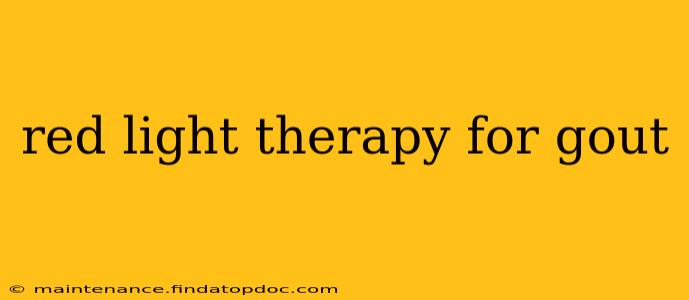Gout, a debilitating form of inflammatory arthritis, affects millions worldwide. Characterized by sudden, severe attacks of pain, swelling, redness, and tenderness in the joints, primarily the big toe, gout is caused by a buildup of uric acid crystals in the joints. While conventional treatments exist, many are exploring alternative therapies, including red light therapy (RLT). This comprehensive guide explores the potential benefits, limitations, and current research surrounding the use of red light therapy for gout.
What is Red Light Therapy?
Red light therapy, also known as low-level laser therapy (LLLT) or photobiomodulation, involves exposing the affected area to low-level red or near-infrared light. This light penetrates the skin and is believed to stimulate cellular processes, potentially reducing inflammation and promoting healing. While the exact mechanisms are still under investigation, studies suggest it can improve blood circulation, reduce pain, and accelerate tissue repair.
Can Red Light Therapy Help with Gout?
This is a complex question with no definitive answer yet. While anecdotal evidence and some preliminary studies suggest potential benefits, more robust clinical trials are needed to confirm its efficacy in treating gout. The potential benefits are largely linked to RLT's anti-inflammatory properties and its ability to potentially improve blood flow. Reducing inflammation is crucial in managing gout flares, and improved circulation might aid in the removal of uric acid crystals.
Does Red Light Therapy Reduce Uric Acid Levels?
Currently, there's limited research directly demonstrating that red light therapy reduces uric acid levels in the blood. While some studies show potential for reducing inflammation, which is a factor in gout, the impact on uric acid itself needs further investigation. It's important to remember that lowering uric acid levels is a key component in managing gout long-term, and RLT alone may not be sufficient for this.
How Effective is Red Light Therapy for Gout Pain?
Some individuals report a reduction in gout pain after using red light therapy. The anti-inflammatory effects of RLT may contribute to pain relief. However, the effectiveness varies, and the pain relief may be temporary, particularly without addressing the underlying cause of the gout. The level of pain reduction likely depends on factors such as the severity of the gout, treatment duration, and the individual's response to the therapy.
Is Red Light Therapy a Safe Treatment for Gout?
Generally, red light therapy is considered a safe treatment with minimal side effects. However, some individuals may experience mild skin redness or warmth at the treatment site. It's crucial to follow the manufacturer's instructions and choose a reputable device. People with certain medical conditions should consult their doctor before using RLT, especially those with photosensitivity.
How to Use Red Light Therapy for Gout
The application method involves shining the red light device onto the affected joint for a specified duration. Treatment protocols vary, and it's essential to follow the manufacturer’s instructions. Consistency is key, as results often require regular treatments over several weeks. Consider consulting a healthcare professional or a qualified RLT practitioner for personalized guidance on treatment parameters.
Red Light Therapy vs. Conventional Gout Treatments
Conventional gout treatments typically focus on managing pain and lowering uric acid levels. These include medications like NSAIDs, colchicine, and allopurinol. Red light therapy might be considered a complementary or adjunctive therapy alongside conventional treatments, but it shouldn't replace them without medical advice.
Conclusion: The Promise and Limitations of Red Light Therapy for Gout
Red light therapy shows promise as a potential complementary therapy for managing gout, particularly in reducing inflammation and pain. However, more rigorous research is necessary to definitively establish its efficacy and to determine its optimal application parameters for gout management. It's crucial to consult with a healthcare professional before using RLT for gout or any other medical condition. They can help determine if it's appropriate for you and advise on its use alongside conventional treatments. Never rely solely on RLT for gout management without professional medical guidance.
